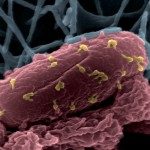Link to Pubmed [PMID] – 32650458
Link to DOI – E73710.3390/v12070737
Viruses 2020 Jul; 12(7):E737
Enteropathogenic Escherichia coli (EPEC) is a major pathogen for diarrheal diseases among children. Antibiotics, when used appropriately, are effective; however, their overuse and misuse have led to the rise of antibiotic resistance worldwide. Thus, there are renewed efforts into the development of phage therapy as an alternative antibacterial therapy. Because EPEC in vivo models have shortcomings, a surrogate is used to study the mouse pathogen Citrobacter rodentium in animal models. In this study, two new phages CrRp3 and CrRp10, which infect C. rodentium, were isolated and characterized. CrRp3 was found to be a new species within the genus Vectrevirus, and CrRp10 is a new strain within the species Escherichia virus Ime09, in the genus Tequatrovirus. Both phages appear to have independently evolved from E. coli phages, rather than other Citrobacter spp. phages. Neither phage strain carries known genes associated with bacterial virulence, antibiotic resistance, or lysogeny. CrRp3 is more potent, having a 24-fold faster adsorption rate and shorter lytic cycle when compared to the same properties of CrRp10. However, a lysis curve analysis revealed that CrRp10 prevented growth of C. rodentium for 18 h, whereas resistance developed against CrRp3 within 9 h. We also show that hypoxic (5% oxygen) conditions decreased CrRp3 ability to control bacterial densities in culture. In contrast, low oxygen conditions did not affect CrRp10 ability to replicate on C. rodentium. Together, CrRp10 is likely to be the better candidate for future phage therapy investigations.




